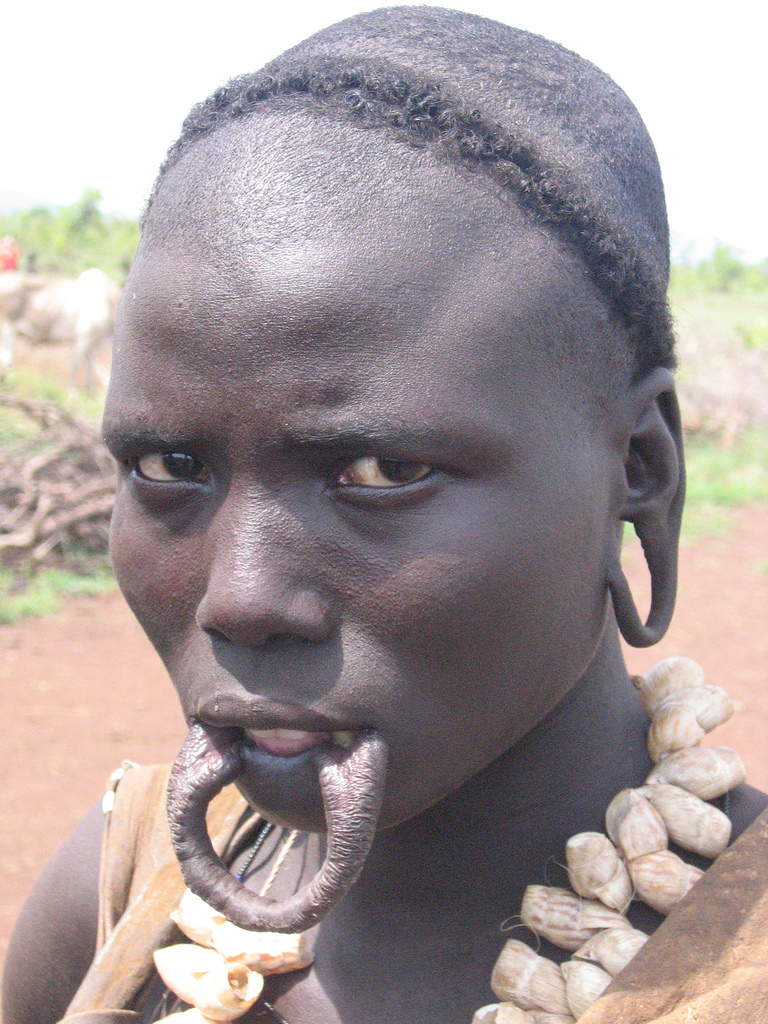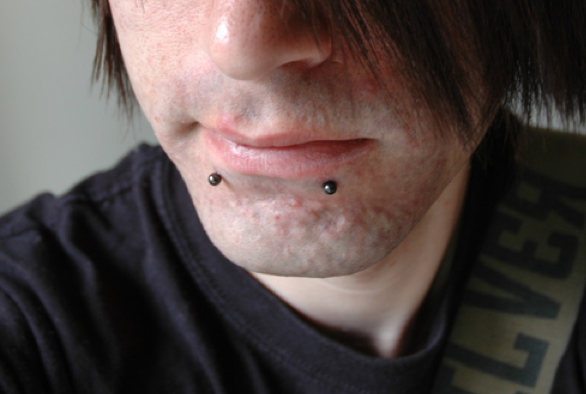|
Labret Piercing
A labret is a form of body piercing. Taken literally, it is any type of adornment that is attached to the lip (labrum). However, the term usually refers to a piercing that is below the bottom lip, above the chin. It is sometimes referred to as a "tongue pillar" or a "soul patch piercing". Pronunciation The traditional pronunciation of ''labret'' in anthropology is . It derives from the Latin ''labrum'' "lip" and the diminutive suffix ''-et.'' However, many in the body-piercing industry give it the pseudo-French pronunciation , though the French word is in fact borrowed from the English.''How do YOU Say L-a-b-r-e-t?'' (note: the etymology here is false.) Anthropology The labret was a traditional piercing among the American Northwest Coast Indians, where it was related t ...[...More Info...] [...Related Items...] OR: [Wikipedia] [Google] [Baidu] |
Body Piercing
Body piercing, which is a form of body modification, is the practice of puncturing or cutting a part of the human body, creating an opening in which jewelry may be worn, or where an implant could be inserted. The word ''piercing'' can refer to the act or practice of body piercing, or to an opening in the body created by this act or practice. It can also, by metonymy, refer to the resulting decoration, or to the decorative jewelry used. Piercing implants alter body and/or skin profile and appearance (e.g. golden threads installed subdermal, platinum, titanium or medical grade steel subdermal implants). Although the history of body piercing is obscured by popular misinformation and by a lack of scholarly reference, ample evidence exists to document that it has been practiced in various forms by multiple sexes since ancient times throughout the world.Body piercing can be performed on people of all ages, although most minors are only permitted to have earlobe piercings. Ear piercin ... [...More Info...] [...Related Items...] OR: [Wikipedia] [Google] [Baidu] |
Alutiiq Language
The Alutiiq language (also called Sugpiak, Sugpiaq, Sugcestun, Vocabulary comparison The comparison of number terms and month names in the two dialects: References Further reading * Bass, Willard P., Edward A. Tennant, and Carl Anahonak. ''Test of Oral Language Dominance Sugpiaq Aleut-English''. Albuquerque, N.M.: Southwest Research Association, 1973. * Counceller, April Gale Laktonen, Jeff Leer, and Nick Alokli. ''Kodiak Alutiiq Conversational Phrasebook With Audio CD''. Kodiak, Alaska: Alutiiq Museum & Archaeological Repository, 2006. * Leer, Jeff, Carl Anahonak, Arthur Moonin, and Derenty Tabios. ''Nanwalegmiut paluwigmiut-llu nupugnerit = Conversational Alutiiq dictionary : Kenai Peninsula Alutiiq''. Fairbanks, AK: Alaska Native Language Center, University of Alaska Fairbanks, 2003. * Leer, Jeff, and Nina Zeedar. ''Classroom Grammar of Koniag Alutiiq, Kodiak Island Dialect''. Fairbanks, AK: Alaska Native Language Center, University of Alaska Fairbanks, 1990. * Leer, ... [...More Info...] [...Related Items...] OR: [Wikipedia] [Google] [Baidu] |
Tembetá
A tembetá (Guaraní language: ''tembé'': lip, ''Ita'': stone.) or barbote (Argentina) is a metal or stone rod placed in lower lip piercings by members of some indigenous peoples in South America. It has been used since the Neolithic period by different human groups for body modification, spiritual protection, and indication of sexual maturity. Pre-Columbian use According to the first studies of Jorge Fernández, tembetás originated in Planalto, Brazil. Their use expanded as far south as El Quisco, Chile, and they were adopted by indigenous groups such as the Guarani, Tupi, and Chiriguano peoples. Sociological importance The tembetá played a part in initiation ceremonies, signifying the entry of young men into adult life. After these ceremonies, the men could marry and acquire the responsibilities of an adult male. Corporal use and skill of placement The tembetá is a male adornment in the lower lip. Several men and candidates would meet and drink chicha, a fermented ... [...More Info...] [...Related Items...] OR: [Wikipedia] [Google] [Baidu] |
Lip Plate
The lip plate, also known as a lip plug, lip disc, or mouth plate is a form of body modification. Increasingly large discs (usually circular, and made from clay or wood) are inserted into a pierced hole in either the upper or lower lip, or both, thereby stretching it. The term labret denotes all kinds of pierced-lip ornaments, including plates and plugs. Archaeological evidence indicates that disk and plate labrets have been invented multiple times including in Africa (Sudan, Eritrea and Ethiopia; 5500–6000 BC) Mesoamerica (1500 BC), and coastal Ecuador (500 BC). Usage in Africa In some African countries, a lower lip plate is usually combined with the two lower front teeth, sometimes all four. Among the Sara people and Lobi of Chad, a plate is also inserted into the upper lip. Other tribes, such as the Makonde of Tanzania and Mozambique, used to wear a plate in the upper lip only. Due to the Mursi reliance on tourism, many sources have suggested that the plate's size was ... [...More Info...] [...Related Items...] OR: [Wikipedia] [Google] [Baidu] |
Lip Piercing
A lip piercing is a type of body piercing that penetrates the lips or the area surrounding the lips, which can be pierced in a variety of ways. Procedure and healing Approximate healing time for most lip piercings is between 1 and 3 months; however, there is a possibility of serious infection if the piercing is not properly taken care of. After healing is complete, other jewelry may be used. After this time, some scar tissue may be present, but the fistula is normally fully developed and mostly healed. Aftercare consists of hot saline soaks two to three times daily. Soaking the wound for three to five minutes with a weak saline solution softens any blood and lymph discharge attached to the jewelry. Afterwards, taking a hot shower and using clean hands and a small amount of a mild soap such as castile soap removes excess matter from the site. Turning or otherwise moving jewelry on a fresh piercing is not advised, as it can irritate and lengthen swelling and healing time. Dilut ... [...More Info...] [...Related Items...] OR: [Wikipedia] [Google] [Baidu] |
Body Piercing Aftercare
Body piercing, which is a form of body modification, is the practice of puncturing or cutting a part of the human body, creating an opening in which jewelry may be worn, or where an implant could be inserted. The word ''piercing'' can refer to the act or practice of body piercing, or to an opening in the body created by this act or practice. It can also, by metonymy, refer to the resulting decoration, or to the decorative jewelry used. Piercing implants alter body and/or skin profile and appearance (e.g. golden threads installed subdermal, platinum, titanium or medical grade steel subdermal implants). Although the history of body piercing is obscured by popular misinformation and by a lack of scholarly reference, ample evidence exists to document that it has been practiced in various forms by multiple sexes since ancient times throughout the world.Body piercing can be performed on people of all ages, although most minors are only permitted to have earlobe piercings. Ear piercing ... [...More Info...] [...Related Items...] OR: [Wikipedia] [Google] [Baidu] |
Barbell (piercing)
Barbell style piercing jewelry is composed of a straight bar with a bead on each end, one or both beads unscrewable for removal and/or changing of the beads. Often one of the beads is fixed, either via epoxy or welding, so that only one bead is used to install or remove the jewelry. Barbell threads are usually right-handed. They are named because they resemble the barbells that are used in weightlifting. Types of barbells Internally threaded barbells Named because the bar has smooth ends with receiving threads tapped into the end of the bar. In internally threaded jewelry, the bead has a receiving tube machined into it (this is referred to as "countersunk"), with a threaded post extending from the center, which mates with the threaded receiving tube on the bar. Being much less likely to cause damage and irritation, especially at the time of piercing, internally threaded jewelry is considered superior to externally threaded jewelry. It is usually slightly more expe ... [...More Info...] [...Related Items...] OR: [Wikipedia] [Google] [Baidu] |
Snakebites
A snakebite is an injury caused by the bite of a snake, especially a venomous snake. A common sign of a bite from a venomous snake is the presence of two puncture wounds from the animal's fangs. Sometimes venom injection from the bite may occur. This may result in redness, swelling, and severe pain at the area, which may take up to an hour to appear. Vomiting, blurred vision, tingling of the limbs, and sweating may result. Most bites are on the hands, arms, or legs. Fear following a bite is common with symptoms of a racing heart and feeling faint. The venom may cause bleeding, kidney failure, a severe allergic reaction, tissue death around the bite, or breathing problems. Bites may result in the loss of a limb or other chronic problems or even death. The outcome depends on the type of snake, the area of the body bitten, the amount of snake venom injected, the general health of the person bitten and whether or not anti-venom serum has been administered by a doctor in a ... [...More Info...] [...Related Items...] OR: [Wikipedia] [Google] [Baidu] |
Grigory Shelikhov
Grigory Ivanovich Shelikhov (Григо́рий Ива́нович Ше́лихов in Russian) (1747, Rylsk, Belgorod Governorate – July 20, 1795 (July 31, 1795 New Style)) was a Russian seafarer, merchant, and fur trader who perpetrated the Awa'uq Massacre. Career Starting in 1775, Shelikhov organized voyages of merchant ships to the Kuril Islands and the Aleutian Islands, in what is now Alaska, for fur trading. In 1783–1786, he led an expedition to the coastal shores of the mainland, where they founded the first permanent Russian settlements in North America. Shelikhov's voyage was done under the auspices of his Shelikhov-Golikov Company, the other owner of which was Ivan Larionovich Golikov. This company was the predecessor of the Russian-American Company, which was founded in 1799. In April 1784, Shelikhov arrived in what he named as Three Saints Bay on Kodiak Island with two ships, the ''Three Hierarchs, Basil the Great, Gregory the Theologian and John Chrysostom'' ... [...More Info...] [...Related Items...] OR: [Wikipedia] [Google] [Baidu] |
Southeast Alaska
Southeast Alaska, colloquially referred to as the Alaska(n) Panhandle, is the southeastern portion of the U.S. state of Alaska, bordered to the east and north by the northern half of the Canadian province of British Columbia (and a small part the Yukon Territories). The majority of Southeast Alaska's area is part of the Tongass National Forest, the United States' largest national forest. In many places, the international border runs along the crest of the Boundary Ranges of the Coast Mountains (see Alaska boundary dispute). The region is noted for its scenery and mild, rainy climate. The largest cities in the region are Juneau, Sitka, and Ketchikan. This region is also home to Hyder, the easternmost town in Alaska. Geography Southeast Alaska has a land area of , comprising much of the Alexander Archipelago. The largest islands are, from North to South, Chichagof Island, Admiralty Island, Baranof Island, Kupreanof Island, Revillagigedo Island and Prince of Wales Island. Maj ... [...More Info...] [...Related Items...] OR: [Wikipedia] [Google] [Baidu] |
Diminutive
A diminutive is a root word that has been modified to convey a slighter degree of its root meaning, either to convey the smallness of the object or quality named, or to convey a sense of intimacy or endearment. A (abbreviated ) is a word-formation device used to express such meanings. In many languages, such forms can be translated as "little" and diminutives can also be formed as multi-word constructions such as " Tiny Tim". Diminutives are often employed as nicknames and pet names when speaking to small children and when expressing extreme tenderness and intimacy to an adult. The opposite of the diminutive form is the augmentative. Beyond the ''diminutive form'' of a single word, a ''diminutive'' can be a multi-word name, such as "Tiny Tim" or "Little Dorrit". In many languages, formation of diminutives by adding suffixes is a productive part of the language. For example, in Spanish can be a nickname for someone who is overweight, and by adding an suffix, it becomes which ... [...More Info...] [...Related Items...] OR: [Wikipedia] [Google] [Baidu] |
Tlingit People
The Tlingit ( or ; also spelled Tlinkit) are indigenous peoples of the Pacific Northwest Coast of North America. Their language is the Tlingit language (natively , pronounced ),"Lingít Yoo X'atángi: The Tlingit Language." ''Sealaska Heritage Institute.'' (retrieved 3 December 2009) in which the name means 'People of the Tides'.Pritzker, 208 The Russian name ' (, from a Sugpiaq-Alutiiq term ' for the worn by women) or the related German name ' may be encountered referring to the people in older historical literature, such as |
.jpeg)









